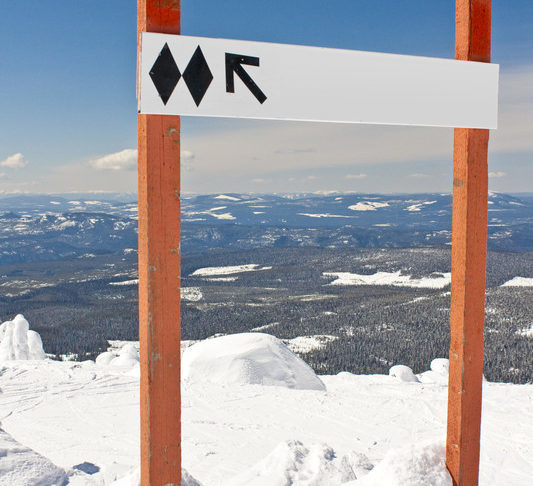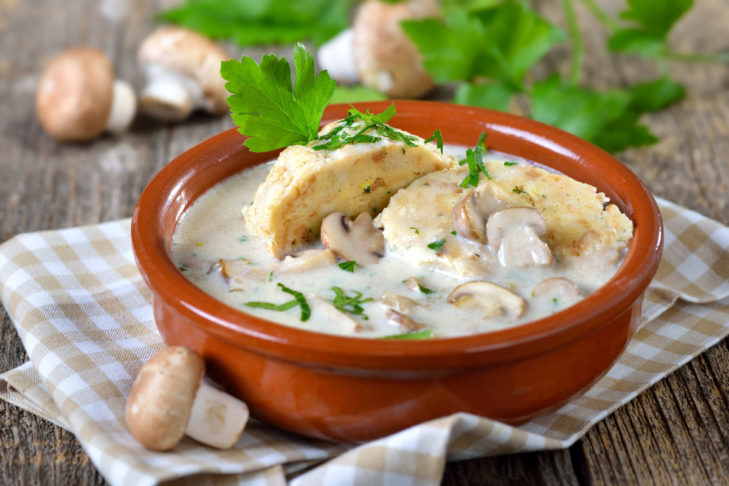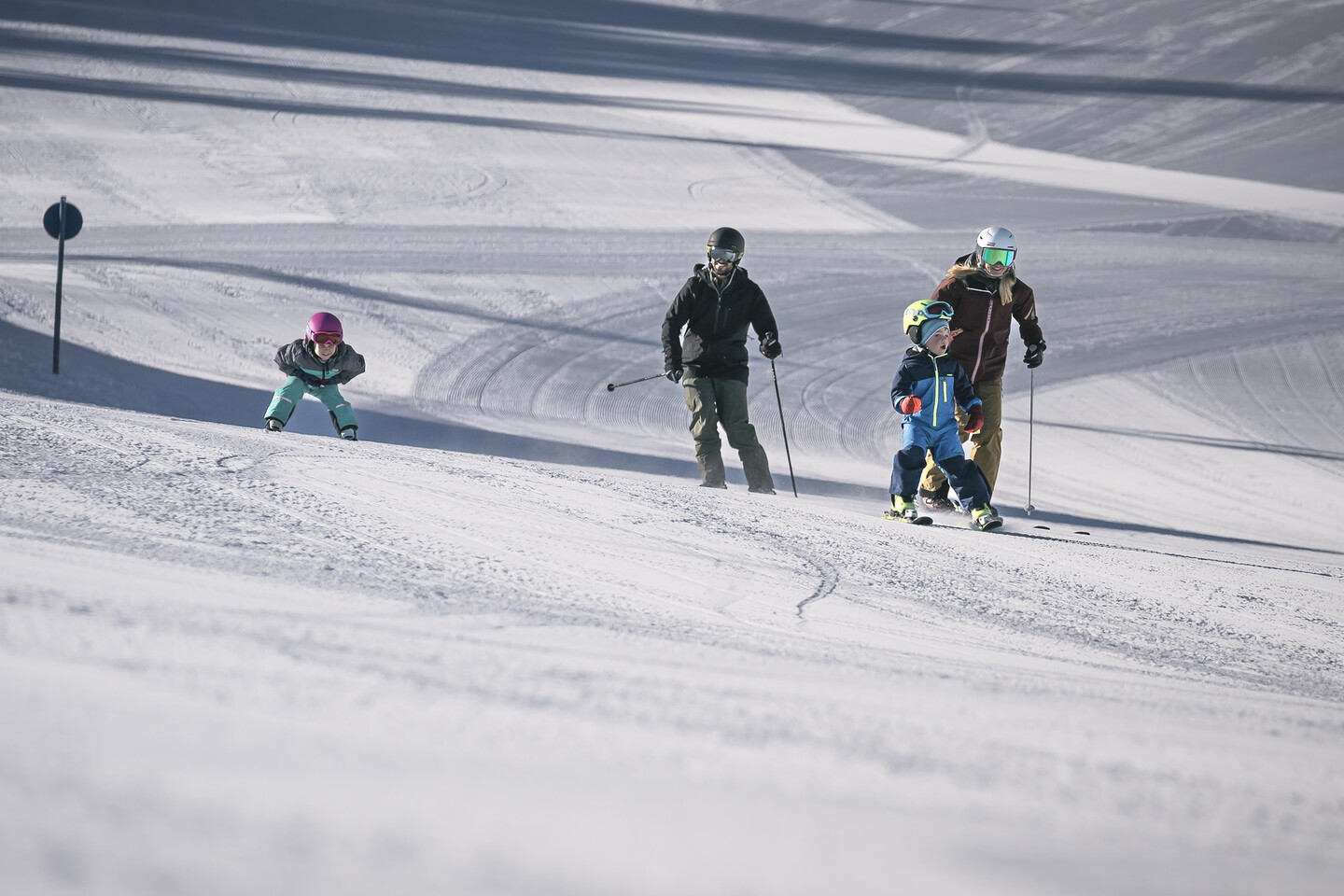In order to be able to fully enjoy the first day on the piste it is important to be well prepared. This does not only mean having good equipment, but also the mental and physical preparation. If you start your first run being fit, and finish your skiing day in a relaxed manner, you will have more fun on the piste.
A good plan makes up half the skiing fun
As soon as the cold season starts, anticipation rises among winter sports enthusiasts. This also means: the fun on the pistes is soon about to start! What should not be forgotten, however, is that good preparation makes up half the fun.
Firstly, long-term planning naturally includes checking the equipment. It is best to have it checked by a professional sports retailer before your skiing holiday to make sure that the binding are adjusted correctly, the skis are well waxed and the edges are sharp.
However, not only the equipment, but also your own body must be in good shape. Experts advise winter sports enthusiasts to stay active all year round. Intense preparation for stamina and muscles should start at least three months before your skiing holiday. Like this you can avoid bone fractures, pulled muscles and other unpleasant sports injuries.
The perfect skiing day starts on the evening before
Once you have arrived in the ski area, it is not really recommendable to go onto the piste completely unprepared. Again: the better prepared you are, the more pleasant will your day on skis be. Ideally, the first day on the poste already starts the evening before.
Get an overview
Make sure you first get an overview of the conditions in the respective ski area:
- Which pistes are there?
- Where are they?
- How do you get there?
- For how long are the ski lifts open?
Before taking your very first run, it is recommendable to start off with easier pistes rather than going down a black piste right away – even if you are an experienced skier. This is because the body first has to get used to skiing and the altitude again. If you ask too much of yourself right from the start, you will risk injury. This is why it is better to slowly approach the difficult pistes.

Apart from getting an overview of the pistes it is also important to check in advance the weather conditions as well as the avalanche warning. Like this you avoid getting into a snow storm right away. Ski apps can be a good help.
Arrange a meeting place
Speaking of: make sure to charge your mobile phone the evening before and save the phone numbers of mountain rescue services. When you ski in a group, each member should take their own mobile phone and have the other skiers’ mobile numbers saved on their phone. In case somebody gets lost along the way, you can stay in touch. Moreover, it is helpful to arrange one or more meeting points at certain times in advance. If someone loses contact with the group in between, the group already has a time and place where to meet up next.
Piste maps and maps of the ski area help finding a good meeting point in a mountain hut or nearby a certain ski lift. It is important that everyone in the group knows the timetable and meeting point. It makes sense to save these on your mobile phone or mark them on the map.
Packing your backpack
The evening before can also be used to check your equipment and pack your backpack. The backpack should contain first aid equipment, a ski service set, sunscreen, as well as small snacks and of course something to drink for in between. Important: sunscreen is best applied in the hotel in the morning, rather than on the piste. This allows the cream to unfold its full effect and you are really protected against sunburn. Attention: Do not forget to re-apply the cream later on.
Another tip for packing your backpack: make sure to take your ID card – many ski areas offer discounts for pupils, students, senior citizens or children.
If you travel with children, the evening before your first day on the piste is also a good time to go through all the rules with them again. It is best to prepare a note with contact information that the children carry with them. This way, you are easy to reach in case they get lost.
The first run: never start off “cold”
Before you finally enter your first piste, you ideally start the day with a good breakfast.
A small breakfast before departure
This does not mean you have to fill your belly at the hotel buffet. – A heavy stomach is not recommended when skiing because it makes you sleepy, worn out and inattentive. However, you should not go skiing without having eaten anything either, as your body will need a lot of energy. A small, balanced breakfast with whole-grain bread, cheese, fruit or muesli and yoghurt is ideal.

Before you start, make sure to check your equipment as well as the weather and local conditions to be on the safe side, as the weather in the mountains can change quickly.
Getting your body used to the mountains
Once you’re finally on the piste, you best start by warming up. If you start skiing “cold”, i.e. without a proper warm-up, you can get injured much faster if you fall. Warming up should be a mixture of stretching exercises and circulatory exercises, such as squat jumps with skis.
When skiing, it’s best to take a break every once in a while. Breaks are important to recover, but also to supply your body with important fluids, so that you stay focused and in good shape. However, this does not mean the alcoholic punch in the next mountain hut, but non-alcoholic drinks such as apple spritzer or mineral water.
For lunchtime, carbohydrates are recommended in order to recharge your energy reserves. Good options are whole-grain bread, egg- or chicken salad, a hearty soup, muesli bars, dried fruit or nuts.

The first day on skis should not be too long, so that your body can get used to the conditions in the mountains. Most accidents happen in the late afternoon, when winter sports enthusiasts get too tired and inattentive. Experts recommend to end your day on skis at about 3 p.m. or 3:30 p.m. However it is important to listen to your own body. If you are already tired at 2 p.m., just quit earlier. Like this, you do not endanger yourself or others on the piste, you can use the afternoon to rest, and start the next skiing day fresh and lively. Moreover, you can always end your day on skis in a cosy mountain hut.
After skiing is before skiing
Nevertheless, there is more to a good run than just preparation. In fact, regeneration after sports is equally important for the body. After all, your muscles were heavily strained, so that it is time to stretch them again and to reduce the activated metabolism. Moreover, the muscles contract during sport, so that stretching afterwards prevents shortening. Regeneration also prevents muscle soreness, relaxes the muscles and makes you both physically and mentally fit for the next skiing day.
Active regeneration
Active regeneration includes a combination of stretching and warm-down right after skiing. You can stretch your arms, back and legs for five to ten minutes and run loosely for ten minutes. Which stretching exercises are the best depends on the person. When it comes to the exercises for warming up and cooling down when skiing, it is advisable to consult a doctor or physiotherapist beforehand.
Passive regeneration
Passive regeneration can include a massage, for example. It does not always have to take place in a spa – a so-called back-roll does not take up much space in your luggage and is very suitable for self-massage and for strengthening and relaxing one’s muscles. In addition, experts recommend going to the sauna. The hot air inside helps the muscles to relax. Make sure not to exaggerate: one to two sauna sessions at temperatures of 60 °C to 70 °C are sufficient.

However, not only warmth helps the regeneration, cold also relaxes your muscles. One option is to take a short ice bath after the sauna. Hot and cold showers also stimulate the blood circulation and relax the muscles.
Nutrition
Nutrition is also part of the recovery phase. It is advisable to drink a lot after skiing and recharge one’s energy with snacks that are rich in carbohydrates, such as bananas or nuts. Dinner can be a little heartier. Good sources of energy are, for example, potato dumplings, stew or cheese noodles. If necessary, this can be complemented with dietary supplements such as magnesium or iron. However, this should not be taken without prior consultation with a doctor or pharmacist.

Sleep
In addition to these regeneration tips, one thing should never be forgotten: Sleep is the best rest for body and mind. Sleep is the time when the body refills its reserves of strength. This is why especially at the beginning of your skiing holiday, you should go to bed rather early in order to allow your body enough sleep. Like this, you can get up fit and fully recovered the next morning and the skiing fun can start all over again.
A perfect skiing day requires both a good preparation and an extensive recovery phase. If body and mind are fit for the piste, you will not only ski more safely – you will also have much more fun.
The most important questions for the perfect skiing day
Why are good preparations important for a perfect skiing day?
Preparation protects against injuries and also avoids unpleasant or dangerous surprises, such as an already closed lift or a snowstorm.
When should the fitness preparation for the skiing holiday begin?
The long-term physical preparation should start at least three months before the skiing holiday. This gives the body enough time to build up the necessary stamina and strength.
Is physical fitness all you need for preparation?
No! As important as physical fitness is, you should always check the weather and local conditions, the piste map as well as the opening hours of the lifts before you start skiing. Furthermore, a safety check of the equipment as well as saving emergency numbers in your mobile phone are obligatory. A balanced diet and avoiding alcohol are also part of a good preparation.
Can I just go skiing unprepared in the morning?
“Cold” skiing without any warm-up exercises is not recommendable, as it increases the risk of injury. Therefore you should warm up briefly with some circulation and stretching-exercises before your first run.
Why do I have to plan for regeneration phases after skiing?
The body is subjected to a lot of strain during skiing. In order to be physically fit and mentally relaxed the next morning, but also to minimise the risk of injury, it is advisable to plan for both active and passive regeneration exercises.
What is the best way for the body to relax after skiing?
Directly after your last run you should stretch your muscles briefly and loosely run for a few minutes. Then you can relax in the sauna, with hot and cold showers or massages. You should also eat a healthy diet, drink a lot, and, above all, allow your body a lot of sleep at night.



